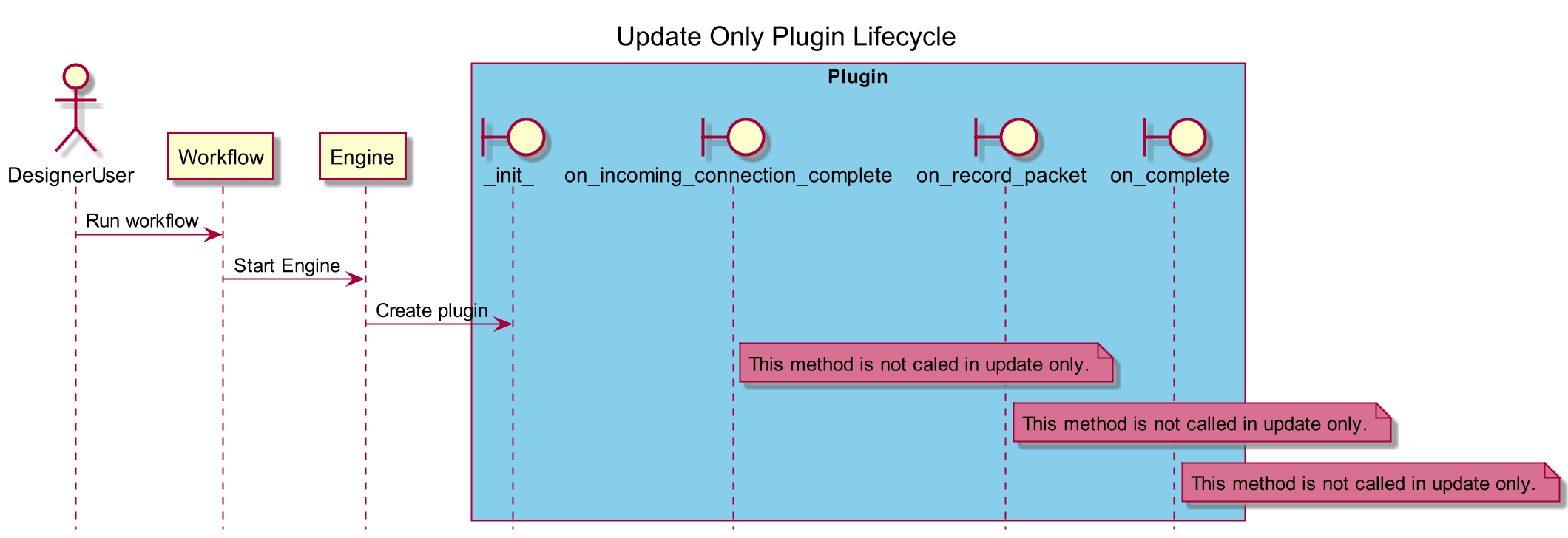Lifecycle of a Plugin¶
Prerequisites¶
This overview refers to Plugins, in reference to any new
PluginV2 class developed with the SDK.
Overview¶
The lifecycle of a Plugin in Alteryx Designer can be broken down into 2
different types of runs:
Workflow Run
Update Only Run
Workflow Run¶
When you select the Run button in Designer, an instance of your
PluginV2 class is created for each of your tools on the canvas.
The PluginV2 is constructed via its __init__ method, just like in
normal Python. An instance of a ProviderV2 class is given to the
plugin. Any resources required to read from and write to Designer can be
obtained via methods/properties on the ProviderV2.
In Alteryx Designer, input anchors can have 1 or many connections.
If you have any input connections, in the next stage of the lifecycle
consists of each of those input connections sends data downstream.
From the PluginV2 perspective, the on_incoming_connection_complete
method is called for each connection once the engine is done sending
records. The parameter that on_record_batch receives is the connection that a new record
packet is available on.
Once all record batches for all connections are received, the
Plugin’s on_complete method is called in order to do any
cleanup.
If your PluginV2 class does not have any input anchors, the lifecycle
is the same, however, on_incoming_connection_complete, and
on_record_batch never get called, since there are no
connections/received records. This means that any records that you wish
to output must be written to the output anchor during the on_complete method (you
shouldn’t write them during __init__, for reasons described below).
In order to write records to your Plugin’s output anchors, they must
first be opened with metadata. This Metadata object describes
the record schema for that output anchor (for example, field names, types, etc.).
Refer to this sequence diagram for a visual representation of this lifecycle:

Workflow Run Sequence Diagram¶
Update Only Run¶
Update only is a mode that runs in Designer any time…
A new tool is added to the canvas.
Any tool on the canvas has a change in configuration (typically, via the user interface or Configuration panel).
The purpose of this run mode is to generate the metadata that each tool will output during the next time a workflow runs. This allows new tools on the canvas to know what columns they can operate on. The metadata that comes out of a tool typically depends on…
The incoming metadata.
The configuration of the tool (via the user interface).
In this mode, only the __init__ method is called.
Since the goal of an update-only run is to build output metadata, the
__init__ method is run. This method has an instance of the AMPProviderV2,
which sets incoming and outgoing anchor information, including the name and metadata.
Additionally, since __init__ runs in update-only mode,
you should aim to perform a minimal amount of
processing in this methods, since a fast update makes users happy.
Refer to the sequence diagram for a visual representation of this lifecycle:

Update Only Sequence Diagram¶